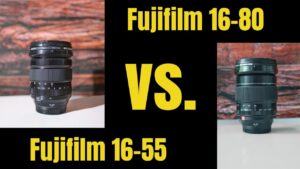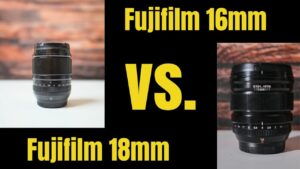Quick Facts about the Fujifilm XF 16mm F1.4
- Weight: 13.23 oz/375 Grams
- Weather Sealed: Yes
- Filter Size: 67mm
- Angle of View: 83.2 Degrees
- Focusing Distance: 5.91″/15cm
- Max Aperture: F1.4
- Minimum Aperture: F16
- Image Stabilization: No
- Mount System: Fuji X
- Price: $999
Table of Contents
Old YouTube video
Who is the Fujifilm 16mm f1.4 for?
Like most people, I always read the reviews of items before I purchase something.
And when I was purchasing my first prime lens for my Fuji camera, I repeatedly read about the Fujifilm 16mm f1.4 lens.
The Fuji 16mm f1.4 (I have to clarify because there is a f2.8) is:
- One of the most highly rated lenses in the Fuji ecosystem.
- One of Fuji’s most popular lenses since its release date in April of 2015.
Some users of this lens even claims that this lens contains “magic.”
Now, I have questions about what the technical definition of magic is. However, in my experience it typically means there is a really good combination of image quality (IQ) and low aperture. (f-Stops)
The Fuji 16mm f1.4 does have both of these characteristics. But do I think it is good for most people?
What other XF wide-angle lenses exist?
The 8-16mm F2.8’s price has recently been lowered to $1,499. On the used market, it can be found for less than $1,000. Although it is difficult to purchase accessories for, the sharpness from center to corner is better than other lenses with this wide of a focal length.
I’ve carried around the 10-24mm F4 for almost two years at this point, and there are a couple of things you should know. It performs better on the wider-end than on the longer-end. (Around 20mm is when the lens starts to struggle.) It’s not actually the best Fujifilm lens for video, as the OIS is good but not great in combination with Fuji’s IBIS. Finally, it’s great for daytime photography. F4 is not enough light for anything at night.
- Fujifilm XF 14mm F2.8
Along with the 18mm F2, this is one of those XF lenses that is not widely reviewed or acclaimed. Some people in Facebook forums swear by it, however.
- Fujifilm XF 18mm F1.4
- Fujifilm XF 16mm F2.8
A pocketable lens for the smaller, XF bodies, the 16mm F2.8 has quick autofocus. Plus, the sharpness is good enough from what I hear. I have not had the pleasure of testing this lens out, as I already own the 16mm F1.4. However, I intend to review it shortly.
- Fujifilm XF 18mm F2.0
One of Fujifilm’s first attempts at creating an XF lens. This lens is one of the smallest within the entire XF ecosystem. I don’t hear a lot about this lens in various forums, nor do I really read any reviews about it, either.
Dials, Switches, Buttons, and More
On this lens, the aperture ring is marked. Additionally, there is an aperture-lock feature on the far left of the aperture range. However, there are no button, and it is quite easy to switch between F16 and A.
Finally, there is a manual focus clutch. The markings on the lens are .15 meters, 0.25, 0.5, 1, and 5 meters.
All around, there are not a buttons. However, the uniqueness of the focus clutch is interesting. From what I have seen, the 16mm f1.4 might be one of the few Fujinon lenses that offer this. (Along with the 14mm F2.8 and original 23mm F1.4.)

Build Quality
The Fuji build quality is one of the main reasons I jumped into the Fuji ecosystem, and the Fuji 16mm f1.4 is no different. This lens is exceptionally built, and it is made out of metal instead of plastic.
Also, this lens is actually weather resistant. (Just don’t change your camera lens out in the elements!)
At 375 grams (.82 pounds), to me, it really doesn’t feel as heavy as it is. The lens shape is short and squatty too, with dimensions of 2.89 x 2.87″ or 73.4 x 73 mm.
For some people, they invest into the X-Mount for compact size, and for some people this lens is still to big. However, I don’t think it is. I would still be able to fit this lens in my jacket pocket if I tried.
The only downside to the 16mm F1.4’s build quality is humidity. When the humidity is high, the lens becomes a little bit slippery to hold. I am not quite sure why, but it may be the paint. This is the same paint that leaves fingerprints, too.
Macro Performance
This lens is a bit of an outlier being a wide-angle lens with a very close focusing distance. The focusing distance of the 16mm F1.4 is 5.91 inches or about 15 centimeters.
So, the maximum magnification ratio is around .20x
Compared to the 14mm F2.8, which has a ratio of .12x, or even the Sigma 16mm F1.4 which is .1x.

Color Fringing
The 16mm F1.4 does suffer pretty heavily from green bokeh fringing. Take, for example, this portrait photo.
It’s pretty evident that there is fringing alongside the cliff, and even down on the beach where the sand and ocean meet.

To take it one step further, I attempted to do a deep dive to see if I can reduce this fringing as I stopped down.
Sadly, the green fringing is still there, even at F2.8. This isn’t necessarily an end of the world phenomenon, but it does take over to stops for the fringing to disappear.
This might be a byproduct of the lens construction circa 2015. However, the newish Fujifilm lenses do much, much better.
Autofocus Test
AF Speed +0
Continuous Autofocus
The 16mm F1.4’s autofocus has seen a significant improvement with the introduction of the X-Trans IV and V sensors, however, the lens does again lag behind in the autofocus realm.
First off, there is a pretty noticeable motor noise. I have used this lens in videos with a shotgun microphone, and this is actually noticeable. (Fixable but noticeable)
Additionally, the autofocus does hunt a bit, too. The system and settings you use will vastly affect this more than the lens, but it just seems less confident.
All around, I think that if you are relying on Autofocus, the 16mm F1.4 is excellent for photography and occasionally videography.
Bokeh Review
I was not a huge fan of the bokeh from the 16mm F1.4, but this is more due to the focal length and aperture combination rather than the actual rendering from the lens.


If you really need good bokeh from Fujifilm lens, there are better alternatives.
Bokeh Balls
A shocker to say the least, there were no major defects with the bokeh balls.
No cat’s eye, onion rings, soap bubbles, or anything of that sort.
At F1.4, I really cannot think of a lens that performs better at similar focal lengths and with this lens mount in regard to bokeh balls.
Sharpness
In regard to sharpness from center to corner, the Fujifilm 16mm 1.4 performs good-enough for most prime lenses, and it is noticeably better than the zoom options by Fujifilm.
Center
Starting off at the minimum aperture (F1.4), the 16mm F1.4 starts off excellent. And it slowly gets better at F2 and F2.8. I think peak sharpness for the enter of the frame performs the best from F2.8 until about F11 or so. Additionally, we really don’t see the same drop off at F11 in the center as we did in the corner. F16 is passable.
Corner
The corner starts off more good than excellent at F1.4, but it is excellent by the time you reach F2.8.
Distortion
Nothing to really report. Prime lenses, from my testing, often have less distortion than zoom lenses.
Vignetting
Similar to distortion, I did not notice any major vignetting with this lens. I checked with both JPEG images that were straight out of the camera (which I imagined were fixed in-body) and the RAF files in Capture One.
Sunstars
The sunstars on the 16mm are good but not great. I was able to achieve solid points around F14. This isn’t the best focal length to achieve sharp images with this lens, either.
Ghosting/Flaring
There is some slight ghosting, and it does not matter if you use a larger or smaller aperture.
I really don’t think it is distracting in any way, however. It’s also not as bad as the 18mm F1.4, so that’s a plus.
The ghosting in the video below will be a little purple blob.
Astrophotography
Whenever people hear that the lens has a maximum aperture of 1.4 AND it is a wide angle, most people will automatically assume it is good for astrophotography.
However, the Fuji 16mm f1.4 is an exception to the rule.
The camera suffers from coma, especially in the corners at f1.4.

What is coma? Coma in photography is when you start getting cones from the light sources. In this case, the coma turns the stars (circles) into little cones.
The great thing about coma on this lens is it is limited. It will show up on long exposure photography, but it won’t for anything less than 5 seconds.
If you want to read more about coma and the Fuji 16mm f1.4, a great thread on DP Review can be found here.
One note: The coma is also completely gone by the time you reach the aperture of f2.8.
My Final Notes
- The Fujifilm 16mm f1.4 lens is built better.
- The Rokinon/Samyang is 1/4 the price.
- The Rokinon/Samyang also is manual-focus only.
But am I going to keep the lens? Yes. Here’s why
- Cost
- Field of FOV
- Photo focused, not video focused.
Not going to lie, there is a major opportunity cost to switch from the 16mm or 18mm. Finally, I really do think the 24mm field of view is perfect for documentary/landscapes/cities/street photography.
My Rating
Price: 3.5/5
With the MSRP holding at $999, this lens is too expensive compared to the newer Fujifilm 18mm F1.4 WR.
On the bright side, this does mean you can get an excellent copy for less than $600 sometimes.
Reliability: 4/5
We lost half-a-point for the green fringing. And another half-a-point is lost for the autofocus concerns on both the older and newer bodies.
Functionality:
-.5 for the manual focus clutch being pretty loose.
Style:
Total: /20






































